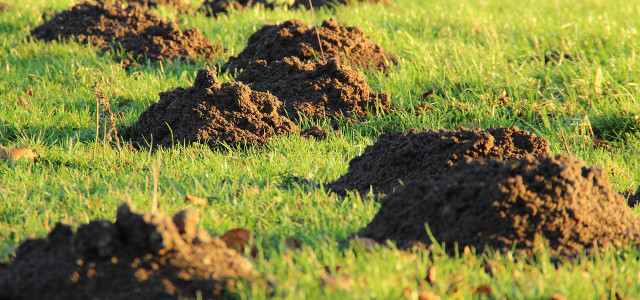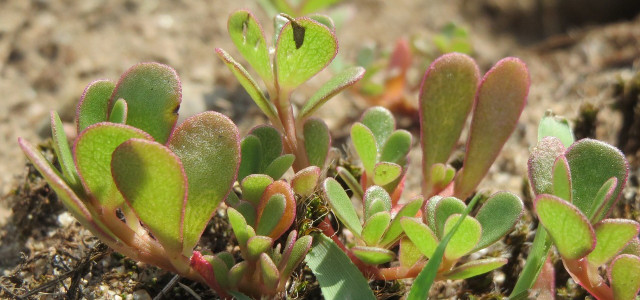From spoiled milk to dish soap or caster oil, learn how to get rid of moles in your yard with these 6 fast-working natural methods — they work on gophers, too!
Molehills and gopher holes can be a garden nuisance, but they can also indicate good soil quality. Before you dive into “how to get rid of moles in your yard,” consider this: these tunneling creatures are nature’s pest control, gobbling up insects and grubs — moles can eat half their body weight in pests daily. Their digging also aerates your soil, boosting its fertility.
Still keen on eviction? Remember, these animals deserve humane treatment. Poison isn’t just harsh; it harms your soil and the broader ecosystem. Similarly, live traps are a no-go — moles’ fast metabolisms mean they can quickly starve if not promptly released.
Not sure whether you’re dealing with a mole or a gopher? The National Wildlife Federation’s guides to moles and gophers can help. Accurate identification aids in deciding the best eco-friendly deterrents, which we’re about to dive into now. Here’s how to humanely and sustainably encourage your uninvited garden guests to move along.
How to Get Rid of Moles in Your Yard: Understand Moles vs. Gophers
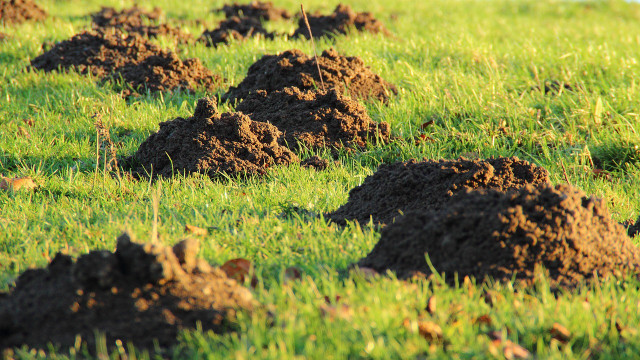
(Foto: CC0 / Pixabay / meineresterampe)
Moles and gophers, though sometimes seen as garden nuisances, play significant roles in our ecosystem.
Moles are smaller, insect-loving mammals that feast on earthworms and grubs. They’re industrious diggers, and their tunneling aerates your soil. So, while they disrupt your lawn, they’re also a natural pest control and soil health booster.
Gophers, slightly larger, favor a plant-based diet, feasting on roots and tubers. They also contribute to soil aeration with their digging, benefiting the overall soil health.
Knowing which animal you’re dealing with will help you choose a suitable, humane approach for how to get rid of moles in a garden, which we’ll discuss next.
1. Get Rid of Moles and Gophers Using Smells
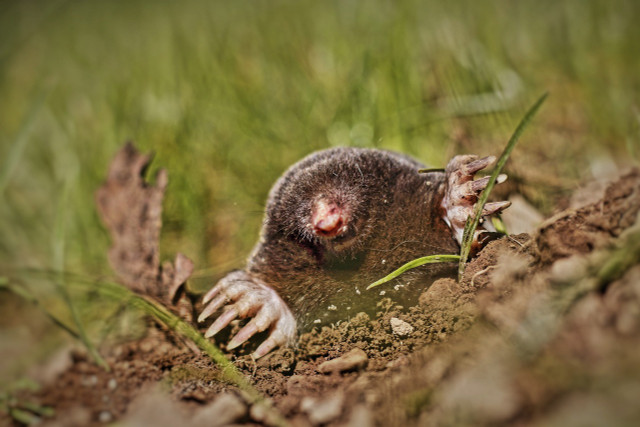


(Foto: CC0 / Pixabay / Tabble)
Moles and gophers have an excellent sense of smell, making them highly sensitive to certain scents — especially those they find unpleasant. Using these natural odors, you can create an environment encouraging them to look for a more appealing home.
All you need to do is place the scented item at the hole’s entrance or dig into molehills and add it there. The aim is to get the odor distributed evenly into the tunnel system.
Here are a few natural items to help you get moles out of your yard:
- Human or Dog Hair: Gather some clumps of hair and add them near the holes and tunnels. The scent of these predators can deter moles and gophers.
- Garlic or Spicy Horseradish: Grate some garlic or horseradish, mix with water, and then carefully pour into the mounds. These strong smells can be pretty off-putting for our garden residents.
- Elderflower Decoction: For this solution, boil a decoction of elderflowers and let it steep for three days. Then pour it into the mounds.
- Spoiled Milk: The strong scent of spoiled milk can act as an excellent repellent. Simply pour some into the tunnels.
- Pet Waste: Though not the most pleasant for us, placing pet waste near the holes can work as a deterrent due to the animal’s smell and scent.
Replace the scented items once or twice a week for the best results. Continue this process until no new molehills or gopher holes form. While this method requires a bit more hands-on work, it’s an effective, natural way to get rid of moles in your garden.
2. Vibrations and Noise to Keep Moles and Gophers Away



(Foto: (Photo: CC0 Public Domain/Unsplash/Glen Michaelsen))
If your garden guests are still digging in their heels (or rather, their claws), let’s turn up the volume a little with noise and vibrations. You might be surprised to learn that moles have highly sensitive hearing — even the tiniest of vibrations can send them scurrying.
Let’s look at a couple of home remedies that use this knowledge to your advantage:
How to Get Rid of Moles in a Garden Using Empty Bottles
Glass bottles can be your allies in this garden mission. Here’s how:
- Find some empty glass bottles without lids.
- Stick these into the molehills at an angle, leaving only the neck sticking out.
What does this do? When the wind blows across the mouth of the bottle, it creates a low humming sound. While this noise is barely audible to us, it creates sound waves that moles find irritating. Over time, this can be enough to encourage them to find quieter areas.
How to Get Rid of Moles in a Garden Using Homemade Wind Chimes
Taking the sound strategy up a notch, you can create a DIY sound deterrent with items you probably have lying around:
- Place metal rods into the ground at several locations in your garden.
- Attach empty soda cans to the top of the rods with a string.
When the wind moves the cans, they will hit the metal rod, creating noise. Again, while this might seem like gentle music to you, for moles, it’s an annoyance that could make them reconsider their living arrangements.
Remember, with any of these methods, consistency is key. And while you want to deter moles and gophers, you also want to respect your neighbors’ peace and quiet. Aim for a balance between an effective deterrent and a sound level that won’t disturb the neighborhood.
3. How to Get Rid of Moles With the Help of Natural Predators



(Foto: CC0 / Pixabay / Alexas_Fotos)
Nature has its unique way of balancing things out, and this applies to our gardening woes too. Both moles and gophers come with a guest list of natural predators, including foxes, weasels, coyotes, barn owls, hawks, badgers and snakes.
Introducing or supporting these predators can be a humane and natural solution to your mole and gopher problem. You encourage them to make a home in or around your garden by offering suitable shelters and habitats. This approach not only deters moles and gophers but also encourages ecosystem diversity.
Creating a shelter can be as simple as constructing piles of wood, leaves or stones. These small sanctuaries provide excellent hiding spots for creatures like weasels, foxes and even snakes. For aerial hunters like hawks and barn owls, keep some branches free as ideal perches.
The idea here is to encourage a natural balance. Over time, with sufficient predator activity, moles and gophers may choose to relocate, solving your problem organically.
A quick tip: If your efforts aren’t working, take a closer look at those mounds. Occasionally, the culprits aren’t moles or gophers but voles — smaller mammals that are less sensitive to changes and harder to deter. Proper identification is crucial.
4. How to Get Rid of Moles in Your Yard Using Castor Oil
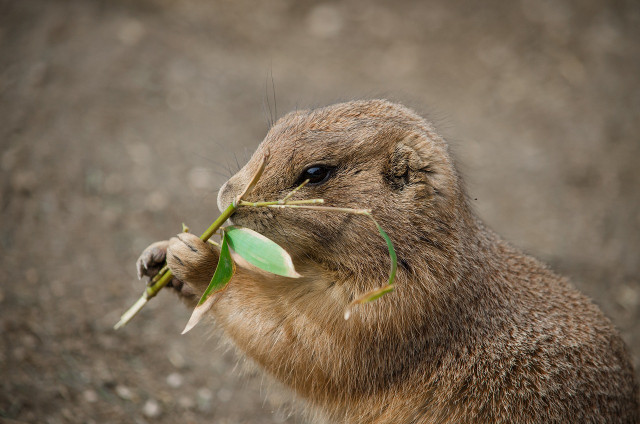


(Foto: CC0 / Pixabay / strichpunkt)
Next up on our eco-friendly toolkit is a pantry staple — castor oil. The same stuff hailed as a hair and skin superhero can also come to your garden’s rescue, as moles and gophers aren’t fans.
These tiny animals find the taste and smell of castor oil unappealing, making it a practical, non-toxic way to get rid of moles naturally. Ready to give it a shot? Here’s how to get rid of moles naturally using caster oil:
DIY Castor Oil Treatment
Ingredients:
- 1/2 cup of castor oil
- 2 gallons of water
- A squirt of dish soap (optional)
Instructions:
- Mix the castor oil with the water and add a squirt of dish soap to help it blend well. Pour this mixture into a spray bottle or garden sprayer.
- Spray your garden, focusing mainly on mole and gopher activity areas. Don’t forget to reapply after heavy rainfall!
Remember, the goal here is to gently encourage the animals to move, not to harm them. Castor oil is not harmful to moles, gophers or your garden, making it a guilt-free choice.
5. Dish Soap Treatments



(Foto: (Photo: CC0 Public Domain/Unsplash/Matthew Tkocz))
A surprising but effective treatment for your mole and gopher problem might be sitting right by your kitchen sink — dish soap. This household essential, known for cutting through grease, can also serve as a humane deterrent for moles and gophers.
Tip: For an even more eco-friendly remedy, mix up some homemade dish soap.
Dish soap, when mixed with water and sprayed on your lawn, creates a slippery, soapy environment that moles and gophers find less than ideal for their tunneling habits. The soap doesn’t harm them; it simply encourages them to move to less soapy areas.
DIY Dish Soap Solution
Ingredients:
- 1/2 cup of dish soap
- 1 gallon of water
Method:
Mix the dish soap with water, ensuring the soap is well dissolved. Pour the solution into a garden sprayer or a spray bottle.
Apply this mixture generously over your garden, giving extra attention to areas known for mole and gopher activity. The goal is to create a soapy barrier that deters these garden guests.
As with any garden treatment, make sure to monitor the health of your plants. While most plants should be fine with the occasional soapy shower, some may not appreciate it. If you notice any adverse effects, you might want to dial back the dish soap treatment.
6. Plant the Right Plants to Deter Gophers
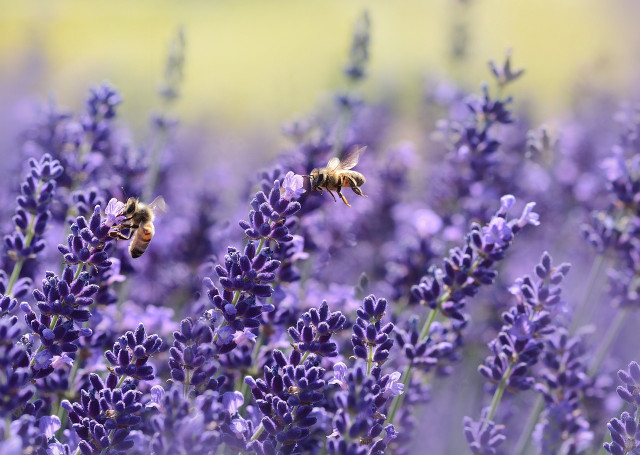


(Foto: CC0 / Pixabay / castleguard)
Rounding up our list of eco-friendly methods for how to get rid of moles naturally are plant repellents. There are certain plants that moles and gophers find distasteful or unpleasant, either because of their scent, taste or both.
Here’s a list of mole and gopher-repelling plants that can double up as beautiful additions to your garden:
- Lavender
- Shasta Daisies
- Rosemary
- California Fescue Grass
- Foxglove
- Daffodil
- Hyacinth
- Ornamental Allium
- Marigolds
Beyond their mole-deterring abilities, many of these plants have other garden-friendly qualities too. Lavender, for instance, creates a mole and gopher-unfriendly environment and attracts pollinators and is one of the plants that repel mosquitoes. Similarly, apart from deterring moles and gophers, rosemary brings bees and butterflies while warding off other pests.
How to Keep Moles and Gophers Away Long-Term
Now that you know how to get rid of moles in your yard, maintaining a mole and gopher-free garden isn’t just about managing a current issue — it’s about taking preventive steps. Here are a few tips to help you keep them away in the long term:
1. Regularly Monitor Your Garden: Keep an eye on your garden. Early detection of molehills or gopher holes can help you manage the situation before it becomes a larger problem.
2. Maintain a Predator-Friendly Environment: Encourage natural predators by providing habitats like piles of wood, leaves and stones, or free branches for birds of prey.
3. Regularly Apply Castor Oil and Dish Soap Treatments: These treatments can work effectively when applied consistently. Regular application helps keep the scent and texture of your garden unappealing to moles and gophers.
4. Keep Noise and Vibrations Going: If you have succeeded with the noise and vibrations method, consider maintaining these deterrents. However, do be mindful of potential noise disturbances to your neighbors.
5. Plant Repellent Plants: Even after moles and gophers have moved on, continue to include repellent plants in your garden. They deter moles and gophers, enhance your garden’s beauty and support biodiversity.
Read more:
- How to Get Rid of Aphids: Helpful Home Remedies
- Home Remedies for Flies: How to Get Rid of House Flies
- Removing Moss: How to Kill Moss in Your Lawn
Do you like this post?






